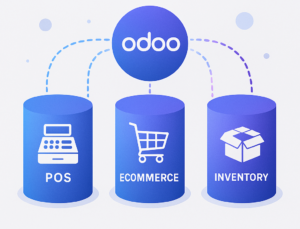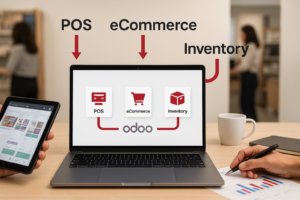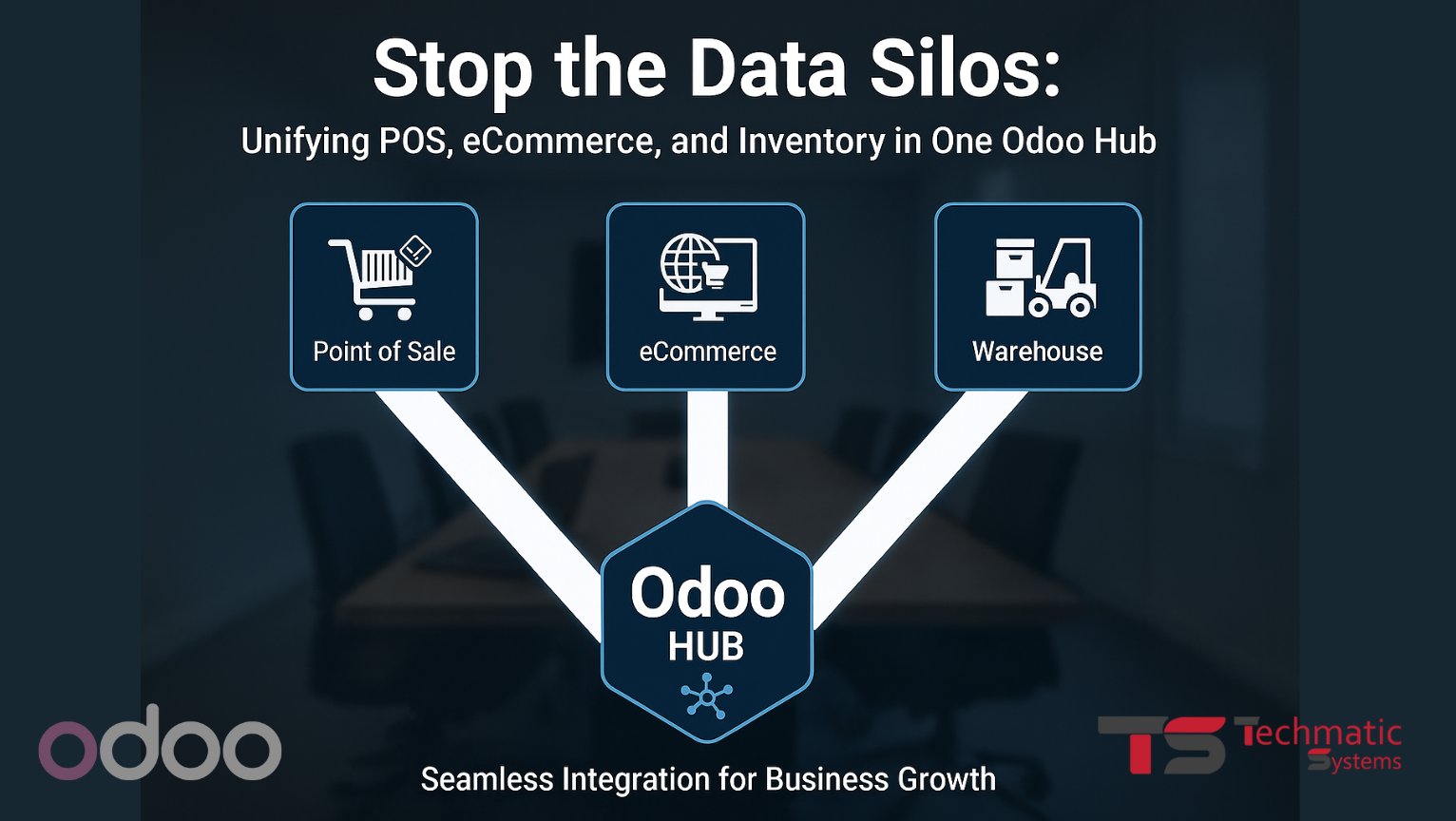The Hidden Cost of Data Silos in Retail
In today’s hyper-connected retail world, businesses run multiple sales channels in-store, online, marketplaces- all serving the same customers but running on disconnected systems.

Each platform- Point of Sale (POS), eCommerce, and inventory- often operates in isolation. The result?
- Lost sales due to stock mismatches
- Poor customer experience
- Slow fulfillment
- Hours of manual reconciliation
These “data silos” not only waste time but also block visibility into your business health. In an age when speed and accuracy drive revenue, disconnected systems can quietly erode profit margins.
Enter Odoo — the unified ERP hub that brings your retail ecosystem under one roof.
Why Retail Data Silos Are a Growing Problem
Retailers use a mix of software to manage operations- Shopify or WooCommerce for online sales, a POS app for physical stores, and a spreadsheet or legacy tool for stock.
Each of these systems “owns” its data. Without real-time integration:
- Sales in-store don’t immediately reflect online inventory
- Inventory updates lag between systems
- Customers order items that are already sold out
This disconnects breeds operational chaos and frustrated customers who see “in stock” online but get “out of stock” emails after checkout.
The result: lost trust, missed opportunities, and double work for your team.
How Odoo Solves Data Silos

Odoo’s modular design unifies retail systems into a single connected database.
Here’s how it works:
- Odoo POS – records all in-store transactions in real-time.
- Odoo eCommerce – handles your online store, orders, and customers.
- Odoo Inventory – updates product quantities instantly whenever an order is processed, online or offline.
Every sale, return, and restock automatically updates the shared inventory, ensuring every channel shows accurate stock availability.
Key Benefits:
- Real-time stock synchronization across all channels
- Unified reporting – no more Excel exports
- Faster order processing – orders flow automatically to fulfillment
- Smarter purchasing – reorder rules and forecasts based on live data
- Improved cash flow – less capital locked in dead stock
With Odoo, your retail data isn’t scattered across silos- it’s connected, consistent, and actionable.
Case Study A: From Chaos to Clarity – The Fashion Retailer’s Transformation
A mid-sized fashion retailer with stores in Mumbai and London faced recurring stock mismatches between their POS and online store.
- Problem: Two separate systems led to overselling and delayed updates. Staff often manually adjusted quantities daily.
- Solution: Implemented Odoo POS, Inventory, and eCommerce in one hub.
- Outcome:
- Inventory updates became automatic
- 25% reduction in stockouts
- 40% improvement in order fulfillment speed
- Unified dashboard showing sales from both regions
Now, the retailer can see every transaction online or offline in a single dashboard. No more late-night stock adjustments.
Case Study B: Multi-Store Electronics Retailer Goes Unified
An electronics retailer operating across India and the US managed both local stores and a WooCommerce website. Data inconsistencies caused duplicate SKUs and conflicting stock reports.
- Problem: Lack of central control and no real-time updates.
- Solution: Adopted Odoo as their single retail hub. Integrated WooCommerce with Odoo using Techmatic Systems’ custom connectors.
- Outcome:
- Centralized product catalog
- Real-time inventory updates across all stores
- 30% reduction in order returns
- Seamless experience for both staff and customers
By connecting every sales point into Odoo, the retailer gained complete visibility into what’s selling, where, and when.
What Makes Odoo the Perfect Hub
Unlike most ERP systems, Odoo doesn’t just integrate data, it makes it flow naturally between modules.
Key Capabilities:
- POS Integration: Instant data push to Inventory and Accounting modules
- eCommerce Sync: Orders, payments, and customers synced automatically
- Inventory Control: Live product availability across warehouses
- Reporting: Consolidated insights from sales, stock, and finance
It’s not just unification — it’s real-time intelligence for better decisions.
Implementation Tips: How to Get Started
Unifying your retail systems requires careful setup. Here’s how Techmatic Systems typically approaches it:
- Assessment: Map your current POS, eCommerce, and inventory systems.
- Migration: Clean and import historical data to Odoo.
- Integration: Configure modules and sync channels (POS, website, warehouse).
- Automation: Set reorder rules, automated alerts, and reports.
- Training: Educate staff on using Odoo dashboards and reports effectively.
With the right partner, this transformation can happen without disrupting ongoing operations.
Why Choose Techmatic Systems
As an Odoo Silver Partner, Techmatic Systems brings deep expertise in retail ERP integrations for clients across India, the UK, and the US.
Our team specializes in:
- Multi-channel Odoo implementations (POS + eCommerce + Inventory)
- Custom connectors for platforms like Shopify and WooCommerce
- Region-specific localization (GST, VAT, etc.)
- Data migration and automation
Whether you’re a growing retailer or an enterprise chain, we help you unlock the full power of Odoo connecting your systems, teams, and data.
Data silos might not be visible, but their impact is massive. From missed sales to inaccurate forecasts, they quietly drain your efficiency and profits.
By unifying your POS, eCommerce, and inventory in one Odoo hub, you don’t just integrate systems- you empower your business with clarity, speed, and control.
Let’s connect your retail world, one Odoo hub at a time.
Contact Techmatic Systems to schedule a free Odoo integration consultation.



